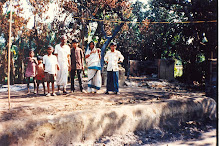Raja
Ram Mohon Roy and Arnos Vale Cemetery of Bristol, England
Sachi
G. Dastidar
For a long time we
wanted to visit the Samadhi of Ram Mohon Roy (also Raja Ram Mohan Roy or Rajah
Rammohun Roy; 1772-1833) and pay homage to the great man. While living in
Dublin, Ireland my wife Shefali and I decided to fly across the Irish Sea and
visit the grave in Arnos Vale Cemetery in Bristol. Ram Mohon is considered by
many as the Father of Indian Renaissance, the Father of Bengal Renaissance, the
Father of the Idea of Modern India, Founder of the Brahmo Samaj reformed
religion in Hinduism which espoused caste less, gender equal, monotheistic, services
in vernacular languages that people can understand easily and formless religion
many of which are now part and parcel of modern Hindu practices. He also fought
against many taboos, social ills and orthodoxy of the time. Ram Mohon was
influenced by the liberal thinking of the Unitarian Church.
Arnos Vale is quite
close to the train station, actually within walking distance of less than a
kilometer on your left as you exit the train station. Two bus routes connect
the cemetery, or one can take a taxi which takes no more than three minutes at
a huge cost. Ram Mohon’s cemetery is barely 100 yards from the entrance as you
turn right towards the Speilman Centre.
Among all the cemetery
architecture with crosses and headstones Ram Mohon’s stands out distinctively as
a Hindu shrine. Arnos Vale Cemetery
Guidebook writes, “An extremely influential religious and political
thinker, he coined the word ‘Hinduism’ as a term for diversity of Indian
religions and wrote extensively on religious and social matters. He stressed
the importance of education for Indians, campaigned for women’s rights and
worked to end the traditional practice of sati, the burning of widows on the
funeral pyres of their husbands…..
“This rare and beautiful
tomb is now a listed monument and has long been a place of pilgrimage for
Bengalis and Indians. It was repaired and conserved in 2008 using money donated
to the Arnos Vale Trust by businessman Aditya Poddar.” (p 35)
The Cemetery has a nice
park-like setting with flowering trees and paths for walking and biking. There
are chapels and lodges among the beautiful monuments in the Cemetery. Now in
the Speilman Centre there are exhibition, information as well as a nice
restaurant. At the East Lodge there is a souvenir center selling cards and
publications dedicated to Arnos Vale and more.
As it is expensive to maintain
such a large property in the middle of the city, the owner of the property proposed
to sell it to developers. To keep the property as a national heritage area citizens
have formed Arnos Vale Cemetery Trust and Friends of Arnos Vale to raise funds
and protect the property. They have to raise one million British pounds to
achieve their goal. CEO of the organization is Juliette Randall. Anyone wishing
to donate money, buy their publication or receive their newsletter may contact YourArnosVale@arnosvale.org.uk,
or call (44) 0117-971-9117 or check the web at www.arnosvale.org.uk. Mrs.
Contractor, widow of an Indian Parsee, is a Member of the Board of Arnos Vale (2013.)
Raja Ram Mohon Roy Tomb
Inscription on the tomb for Rajah Rammohun Roy Bahadoor
Paying Homage
Back Inscription
Paying Homage
A Section of the Cemetery
Tributes left by Admirers
Paying Tribute
View from the Path

Bikers pause for a Look
A Section of the Cemetery
Part of the Cemetery
The Store run by Volunteers



























